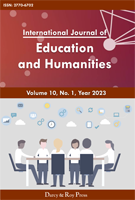English Question Library Generation Algorithm Based on Machine Learning
DOI:
https://doi.org/10.54097/whbckw97Keywords:
Machine Learning, English Question Library, Teaching Resources, Artificial Intelligence.Abstract
In English learning, the teacher wrote the text of the test source according to their own experience. To reduce the complex and repetitive tasks in teaching, teachers can focus on the preparation, teaching and response of teaching, and further improve their teaching ability. It has received the source of test questions through multiple channels and created the test library quickly and efficiently has become the fast-paced requirement of English writing. Machine learning is a mathematical training method that explores how computers mimic human writing behavior and constantly accumulate experience and improve their performance. This is one of the first and most important cases of AI. The purpose of this book is to read the problem of creating algorithms for English question libraries based on machine learning. This project focuses on the creation of machine-based English question library algorithms, hoping to use the rich information resources on the Internet, to quickly create a large test question library using machine learning technology.
Downloads
References
Xuan W , Zeng F . Design of electro-hydraulic servo loading controlling system based on fuzzy intelligent water drop fusion algorithm[J]. Computers & Electrical Engineering, 2018, 71:485-491.
Sengor I, Chuang, Guner S , Erdinc O . Real-Time Algorithm based Intelligent EV Parking Lot Charging Management Strategy Providing PLL Type Demand Response Program[J]. IEEE Transactions on Sustainable Energy, 2020, PP(99):1-1.
Yu H , Lu J ,Hsu, Zhang G . [IEEE 2017 12th International Conference on Intelligent Systems and Knowledge Engineering (ISKE) - Nanjing (2017.11.24-2017.11.26)] 2017 12th International Conference on Intelligent Systems and Knowledge Engineering (ISKE) - Learning a fuzzy decision tree [J]. 2017:1-7.
Saleh E , Valls A , Moreno A , et al. A Hierarchically _L-Decomposable Fuzzy Measure-Based Approach for Fuzzy Rules Aggregation[J]. International Journal of Uncertainty, Fuzziness, and Knowledge-based Systems, 2019, 27 (Dec.Supplpll1):59-76.
Mahela O P , Shaik A G . Recognition of power quality disturbances using S-transform based ruled decision tree and fuzzy C-means clustering classifiers[J]. Applied Soft Computing, 2017:243-257.
He Z , He Y , Liu F , et al. Big Data-Oriented Product Infant Failure Intelligent Root Cause Identification Using Associated Tree and Fuzzy DEA[J]. IEEE Access, 2019, PP(99):1-1.
Cheraghalipour A , Hajiaghaei-Keshteli M , Paydar M M . Tree Growth Algorithm (TGA): A novel approach for solving optimization problems[J]. Engineering Applications of Artificial Intelligence, 2018, 72(JUN.):393-414.
Ai B , Li B , Gao S , et al. An Intelligent Decision Algorithm for the Generation of Maritime Search and Rescue Emergency Response Plans[J]. IEEE Access, 2019, PP(99):1-1.
R Abcan J , Levashenko V , Zaitseva E , et al. Application of Fuzzy Decision Tree for Signal Classification[J]. IEEE Transactions on Industrial Informatics, 2019:1-1.
Kanimozhi U , Manjula D . An Intelligent Incremental Filtering Feature Selection and Clustering Algorithm for Effective Classification[J]. Intelligent Automation & Soft Computing, 2018, 24(4):701-709.
Mcglinn K , Yuce B , Wicaksono H , et al. Usability evaluation of a web-based tool for supporting holistic building energy management[J]. Automation in Construction, 2017, 84:154-165.
Qiao J , Niu Y , Kifer T . Intelligent optimization algorithm for global convergence of non-convex functions based on improved fuzzy algorithm[J]. Journal of Intelligent & Fuzzy Systems, 2018:1-9.
Downloads
Published
Issue
Section
License
Copyright (c) 2024 International Journal of Education and Humanities

This work is licensed under a Creative Commons Attribution 4.0 International License.

















